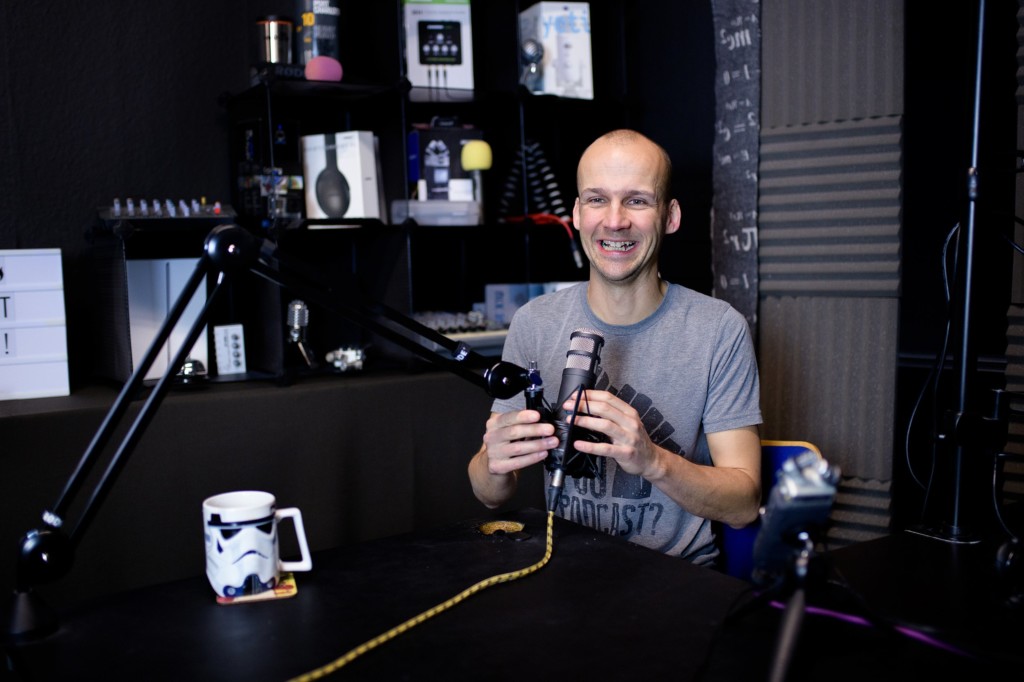“If you like our show, please give us a rating on iTunes, it really helps us get the word out,” says the podcaster—whichever podcaster. Listeners have heard a variation of this line hundreds of times.
Perhaps now and then they’ve been moved enough by a show to plant an online rating, but most of the time, they do nothing. Colin Gray, PhD, an educator turned CEO and founder of UK–based podcast-training firm, The Podcast Host, says each time a host has repeated that message, they’ve missed an opportunity. He likens it to a lesson from classroom teaching: if a teacher has five minutes at the end of a class, they’d be foolish to use that time to repeat the same message. Yet even the best podcasters do it again and again.

Gray believes virtually all podcast hosts can learn from principles of teaching and education, and his perspective on the “end-of-show ask” suggests that ideas from classroom pedagogy might help podcasters keep their listeners engaged and even build community around their content.
Gray insists a lot of podcasts are in the business of teaching people. It may not be obvious, but any time a podcast explains a new subject to listeners, or poses vexing questions and offers answers, they’re engaged in fundamentally the same project as classroom teachers. Gray reckons a majority of existing podcasts are designed to teach listeners in some direct way, and all the rest share a critical challenge with teaching.
“One of the base principles in teaching,” Gray says, “is to engage people. To try to incite curiosity, to keep them interested—this keeps people moving along with you, and listening to what you have to say. I believe a lot of that passes over to podcasting.”
Structured Shows
There are a number of means by which podcasters can apply the principles of teaching to their work, some of which Gray has discussed in detail as part of The Podcast Host’s 10-post series on Content Stacking. Above all, he says, the most consistent means of engaging with listeners comes from creating some kind of discernible structure or scaffolding for the podcast, which clearly prepares listeners for its contents from the beginning. Articulating what a podcast exists to do, and returning to a routine of set-piece segments each episode, can get people to listen more confidently.
“A structure doesn’t have to be extensive or even very strict, and you can deviate from it along the way.”— Gray
“A structure doesn’t have to be extensive or even very strict, and you can deviate from it along the way,” says Gray. What’s important is setting listener expectations at the start of the show—or even before it—by creating long-term expectations. “You can follow a similar format every single episode, so your listeners know what to expect. Even if you go off on a tangent, they know you’ll come back to this other part you always do.”
Gray gives the example of The Bugle, a comedy news show consisting of host Andy Zaltzman cracking jokes with guest comedians about current events. Like many comedy shows, The Bugle could be a formless enterprise of nonstop jokes, yet each episode of The Bugle is broken into recognizable segment formats listeners can expect to hear each time. There will always be a roundup of hilarious fake facts that occurred “on this day in history,” and there will always be a moment in which Andy Zaltzman delivers rapid-fire puns about the day’s events. Even a structure as mild as this, Gray says, helps a listener who’s heard the show once develop a reliable expectation of what they can expect to hear in future shows.
Teachers planning a 90 minute class know they’ll lose students in the first ten minutes if they begin lecturing—and keep it up for the duration. Instead, teachers look at 90 minutes of content as, for example, six 15-minute segments. In some cases, 90 minutes is best served with three five-minute lecture segments on difficult material spaced out between three 10-minute response discussion segments, a 15-minute video on the subject, and 15 minutes of free writing in response to the video. The process of breaking the content into segments gives a teacher control over their class content and how they deliver their information. Likewise, it is in this sort of planning that the podcaster can mastermind a structure designed to maintain listener attention by approaching different parts of the podcast with different intentions.
Imagine a current events show with several hosts who discuss serious issues in culture from a humorous angle. As in the classroom, these podcasters might introduce a difficult subject by first offering a chatty five-minute recap of recent news introducing the subject, before giving one of the hosts a spotlight of a few minutes to deliver a well-researched background of the core issues at play. From there, the host may throw to a 10-minute interview with an expert who deepens the focus of the discussion, before throwing back to a round table of the hosts commenting on and making jokes about the expert’s analysis.
In this way, a 30-minute show can be broken down into:
- A news recap about the subject that reveals its contemporary relevance;
- A studied, polished history of the basic concerns underpinning the subject;
- An interview with an expert offering their opinion, aiming to lead listeners from a general understanding to a clearer sense of how the subject plays out in the real world; and
- An engaging discussion that responds to the expert’s comments with plenty of jokes, while circling back to situate the subject in the news that began the episode.
Let’s say a famous actor was caught in a thorny tax-evasion scheme. An episode about this subject might begin with the hosts discussing and joking about this piece of news, before getting serious (or not!) as one host takes on the role of explaining the hard facts of the tax scheme in question. The expert guest might talk about the famous actor’s history of financial skullduggery, or the prevalence of such schemes among Hollywood players, or even situate the actor’s tax-evasion scheme against similar financial crimes taking place outside of Hollywood. Finally, the hosts get the rest of the show to crack wise about what they’ve just learned, but also to reaffirm the facts of the story and help solidify them in the memory of the listener, the same way a teacher will end a class by returning to a summary of the main facts they’ve discussed thus far.
Freeform shows
Gray knows that many podcasters will turn up their noses at the idea of planning a show’s segments in advance, limiting their length, and even editing segments down to fit into a set timeline. Podcasting appeals to people who like the freedom to invent as they go, he acknowledges, and for shows whose appeal is their lack of structure, this method offers little. Yet the good news is that for producers of free-form or experimental shows, conversation shows, comedy or improv shows, and other deliberately unstructured fare, there’s no need to change any part of the body of the show.
“At the very start, that first 10 or 15 seconds has to make the listener curious enough that they’re going to keep listening.”—Gray
A free-form podcaster can provide structure, Gray says, by letting listeners know what they’re about to hear from the beginning, and promising listeners they’ll learn something they want to know more about. This can be as simple as a ten-second “On this show, you’ll hear…” running down the show’s major issues, and even offering jokes whose punchline is part of the episode.
“Curiosity is the key,” he says. “At the very start, that first 10 or 15 seconds has to make the listener curious enough that they’re going to keep listening. Then there’s expectations: I’m putting my trust in you not to waste my next half hour. Am I going to be safe? Reassure me! Make me trust that I’m in safe hands.”
“All they have to do is have four or five different talking points at the beginning,” he says. “Here are the five things we’re going to cover today.’ These introductions with details about the show and the subjects it contains can be recorded after the fact as summaries of even the most structureless podcast. “That way you can ramble for an hour, but after the fact, you create an intro for the show,” Gray explains. “It’s still a completely rambling show, but you can create curiosity.”
Feedback
Of course, a rambling show—just like a structured, heavily formatted podcast—only works if the producers know what their audience wants to hear. This is one of the few places in which the teaching model departs from podcasting: teachers are usually bound by curriculum requirements and can’t simply ask their students “What would you like to learn?” Podcasters, on the other hand, are in the position to give listeners exactly the sort of learning they want to hear, provided producers ask for information that helps them deliver what their audience desires.
So ask for that information well, Gray says, and don’t waste your chances.
There’s a sleepy-eyed classroom silence that educators learn is their punishment for asking questions too general in scope.
“A much better way to use that end-of-show ask,” he says, “is actually to pick your social media of choice—Twitter or Instagram or whatever—and give people an easy link to go to, and tell you what they think.”
There’s a sleepy-eyed classroom silence that educators learn is their punishment for asking questions too general in scope, so Gray stresses it is important to go beyond asking “How are we doing?” or “What did you think of the show?”
“That isn’t enough of a prompt,” he says, “So ask a specific question! Tell listeners to go to Twitter and answer one question: ‘What struck you most in the story I just told?’ ‘What did you learn most from our guest so-and-so?’ Even better, if it’s something controversial and a lot of people are likely to disagree—that gets you so much feedback.”
Feedback is critical because it shapes the show and helps give podcast hosts a clear sense of what their audience is hoping to get when they cue up an episode.
“All the best shows have pivoted many times over the years,” Gray says. “They change tack, or focus, or ideal audience.” Few podcasts have started out with a clear sense of exactly whom they were speaking to and what that audience wanted to hear. Within a few episodes, with a dozen listeners responding critically on Twitter, many podcasts take a new direction entirely.
“It can take weeks to get that feedback in podcastland, as opposed to minutes when you’re in the classroom and instantly realize everyone’s fallen asleep,” says Gray. But regardless of how long it takes podcasters to collect it, listener feedback can determine the future of a show.
The other reason feedback is so valuable is it tightens a listener community around the podcast. Podcasting may be our most intimate medium, equalizing hosts and listeners in a way that encourages listeners to engage not only with the show but also with other like-minded fans. From the listener’s perspective, Gray says, “There are other people who are like you who are listening to that show too, and feeding back into it.”
“A lot of people waste that end-of-episode ask, and you only really get one,” Gray says. “You see shows trying to get in five or six different asks at the end—‘Give us a rating on iTunes,’ ‘Do our survey,’ ‘Buy our product.’ People will just zone out at that point. But if you don’t squander your opportunity, you can get some really good feedback.”
The more feedback you get, the more you can give listeners what they want. This is as true in podcasts as it is in the classroom, Gray says.
“You can’t teach unless you know what they want to learn. It has to be a two-way thing.”




Comments